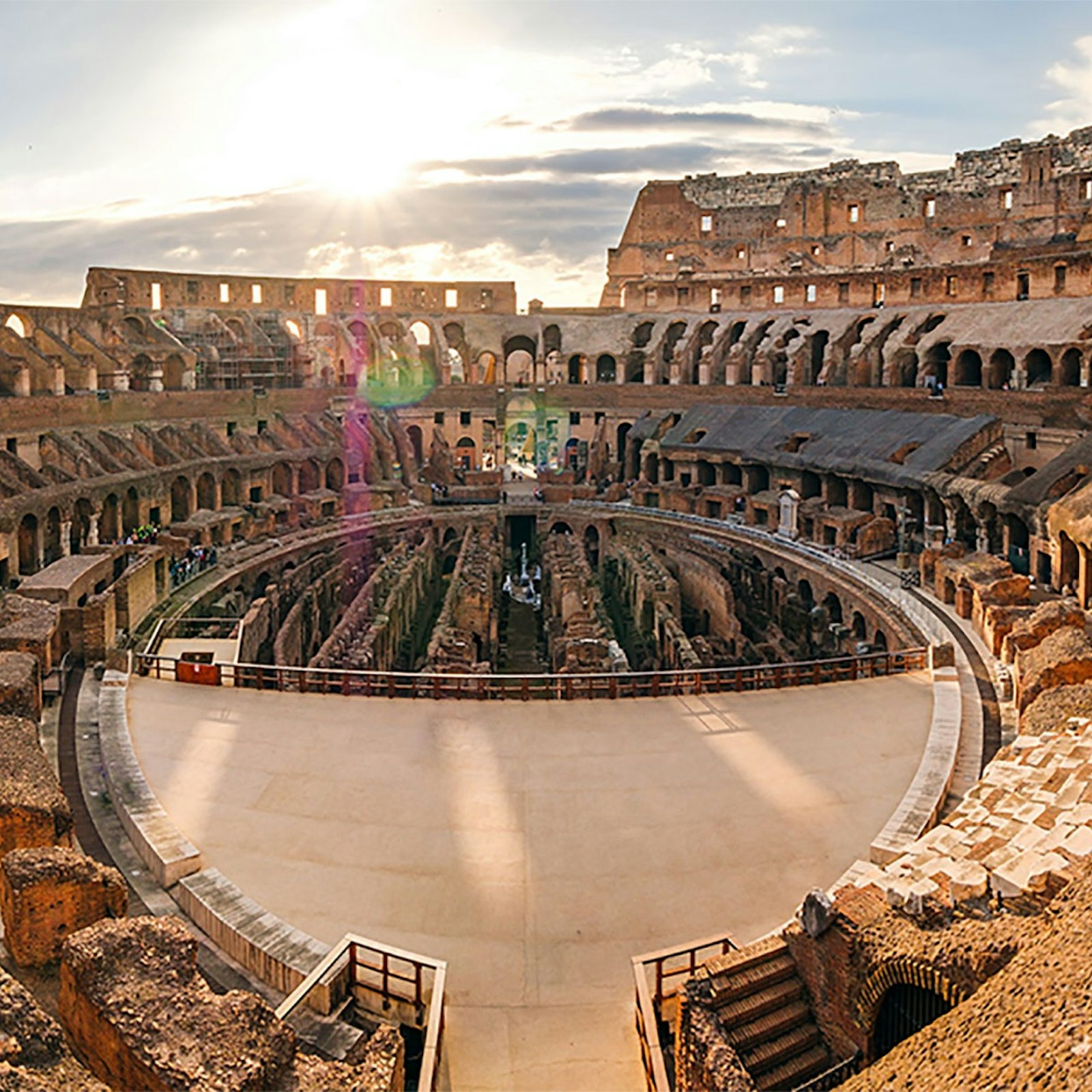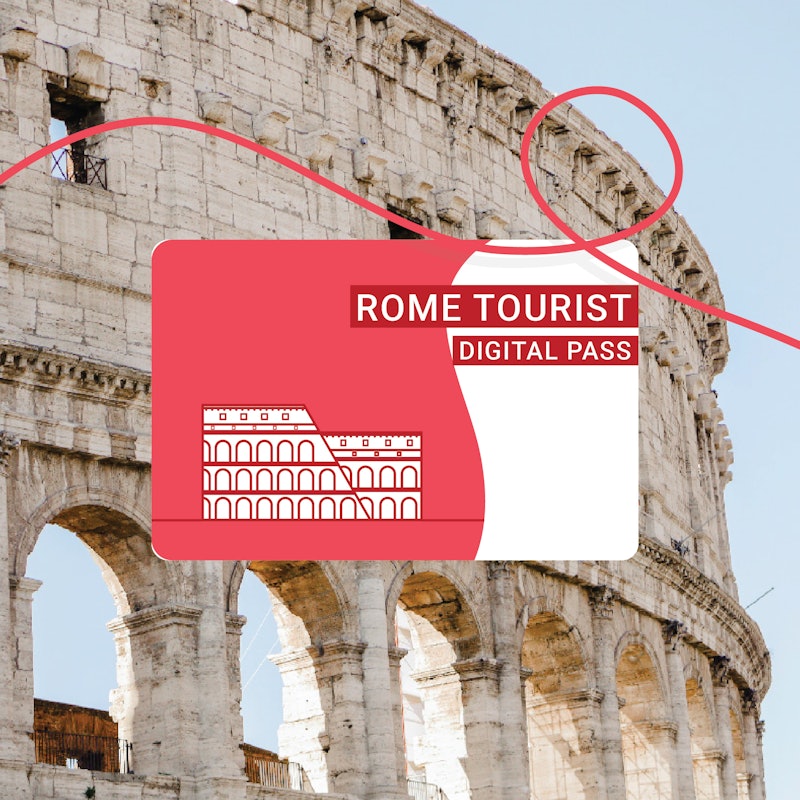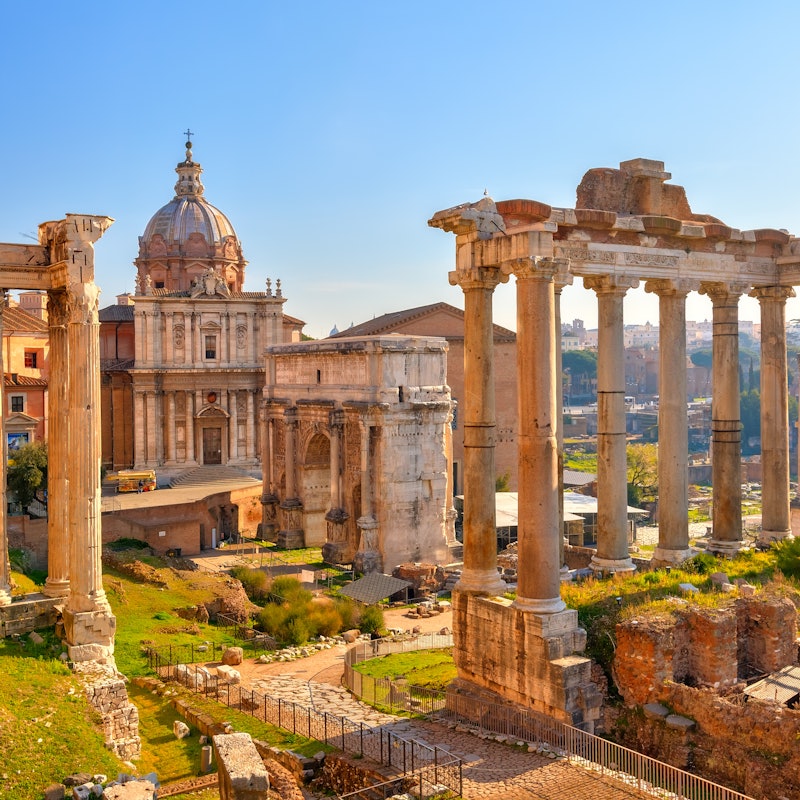Colosseum, Roman Forum & Palatine Hill: Reserved Entrance Ticket + Digital Audio Guide
Step into the rich history of ancient Rome with an audio guide
- Colosseum: Reserved Entry Ticket
- Roman Forum and Palatine Hill: Reserved Entry Ticket
- Downloadable audio guide app

Colosseum, Roman Forum & Palatine Hill - Tickets and Information
- Colosseum Address: Colosseum, Piazzo del Colosseo, 1, Rome, 00184
- Opening Hours: 08:30 - 19:15
Is the Colosseum Worth Visiting
- Its the Colosseum - absolutely!
- It you like historical buildings that are steeped in history, yes, definitely.
What You See At The Colosseum:
- The Colosseum
- The Emperor's Box
- The Gladiator's Gate
- Different areas, depending on your ticket type, such as the arena floor and underground.
{{ticket-block-triple}}
About The Colosseum
The mighty Colosseum in the heart of Rome. One of Italy's most famous landmarks and an icon recognised worldwide. Constructed between 72-80 C.E. by Roman Emperors Vespasian and Titus, it was used as an amphitheatre to host thousands of spectators for gladiatorial combats, animal hunts, mock naval battles, and even public executions.
The Colosseum wasn’t actually known as the ‘Colosseum', the Romans called it the 'Flavian Amphitheatre,'. Had you asked for directions to the 'Colosseum', they wouldn’t have known what you were talking about!
The Colosseum now attracts around 6 million visitors annually, which stands it alongside Vatican City as one of Rome’s most popular tourist attractions!
Historical records suggest it was actively used for around 500 years until the 6th century, and it now proudly holds the title of one of the ‘Seven Wonders of the Modern World’ as well as being listed by UNESCO World Heritage Site under the 'Historic Centre of Rome' category.
Colosseum Architecture
- The Colosseum was built using concrete, sand, and travertine limestone in an elliptical shape with a grandiose façade, which is instantly recognisable.
- It could accommodate up to 80,000 spectators, which given how long ago it was built is a testament to Roman engineering brilliance.
- The exterior features three distinct orders of columns, ‘Doric’, ‘Ionic’, and ‘Corinthian’, highlighting the beauty of classical Roman architecture.
- Beneath the arena, where the gladiators and animals were housed, lies a network of ramps, tunnels, and elevators.
- Spectators were seated according to their social status and wealth, with premium views available at higher costs, much like modern concerts.
- Remarkably, some of the mechanical processes that were used to open trapdoors on the arena floor were advanced engineering feats, allowing dramatic entrances for gladiators and wild animals.
The Colosseum has suffered significant damage over the centuries, including major damage from an earthquake in the 1300s, water damage due to poor ground quality, and looting of stones. Multiple renovation projects have taken place over the years in order to preserve it for future generations. In 2017 after renovations, they reopened the 4th and 5th tiers of the Colosseum which hadn't been open for decades due to damage, and they now offer visitors views of the surrounding areas that hadn't been accessible for many years.
About The Roman Forum
- The Roman Forum Address: Via della Salara Vecchia, 5/6, Rome, 00186.
The Roman Forum was originally built as a marketplace and the centre of political, commercial and social life in Rome. It would have been used for many purposes including elections, public meetings and speeches, as well as having shops, markets and stalls offering local goods and services. The Roman Forum was home to several important buildings such as the Senate House, called the 'Curia', and the Speaker's Platform (called the Rostra), and the local law courts, the 'Basilica Julia'.
Home to some incredible architecture including the 'Temple of Saturn', the 'Arch of Septimius Severus', the 'Temple of Vesta' and the 'Basilica of Maxentius'. Due to its importance, historical events such as the funeral of Julius Caesar would have also been held at the Roman Forum as well as the trail of apostle Saint Paul!
Incredibly the Roman Forum was buried for centuries and it wasn't recovered until the 18th century when excavation works took place.
Things to see at The Roman Forum: There are several temples to see plus other highlights include:
- Via Sacra
- Arch of Titus
- Arch of Septimus Severus
- Temple of Antoninus and Faustina
- Basilica of Maxentius and Constantine
- The Curia and Column of Phocas.
About Palatine Hill
Although quite close to The Roman Forum and the Colosseum, Palatine Hill is a separate location and possibly a little less famous that its neighbours.
Palatine Hill is where the aristocrats and emperors used to live and would have actually been one of the most desirable neighbourhoods in the city. It was one of the Seven Hills of ancient Rome, and holds important historical and archaeological significance as it's believed to have been the birthplace of Rome itself, by Romulus, the mythical founder, in 753 BC.
Today Palatine Hill is an open-air museum which allows visitors to explore the ancient ruins and imagine how life was at the time!
Things to see at Palatine Hill:
- Ruins and a lot of them! But they are fascinating as you can picture what life used to be like when the emperors and aristocrats lived there with their imperial palaces and lavish gardens that would have been home to big statues and shows of wealth and power. We would suggest you try and find the ruins of Domus Flavia, House of Livia, House of Augustus, Farnese Gardens, Hippodrome of Domitian and Palatine Museum.
Popular Tickets
Popular Attractions
Colosseum, Roman Forum & Palatine Hill FAQs
- Do tickets to the Colosseum include access to the Roman Forum and Palatine Hill?
- No. It depends on the type of ticket you buy. Some only give you access to the Colosseum. For tickets to see all three, the Colosseum, Roman Forum and Palatine Hill, just click HERE!
- Do you need to book Colosseum tickets in advance?
- We strongly suggest booking tickets for the Colosseum in advance, yes. Its one of the most popular tourist attractions in Rome, so it does get incredibly busy. Booking in advance allows you to reserve your preferred time and helps you avoid the LONG queues that do form.
- Where to buy Colosseum tickets?
- You an buy your Colosseum tickets right here! Click THIS LINK to see all ticket options.
- What is the cheapest way to get into the Colosseum?
- Click HERE to se all ticket options for the Colosseum. The cheapest option is the Reserved Entrance ticket which costs from €26.00. Price is time and date dependent.
Colosseum Fun Facts
- Largest Amphitheatre: The Colosseum is the largest ancient amphitheatre ever built, capable of holding up to 50,000 to 80,000 spectators.
- Original Name: Its original name was the 'Flavian Amphitheatre', named after the Flavian dynasty of emperors who constructed it. It wasn’t called the Colosseum, as we know it today.
- Gladiator Battles: It was famous for hosting gladiator battles, mock sea battles, and other public spectacles.
- Hidden Levels: Beneath the arena, there were complex underground structures called the "hypogeum," which is where the animals, gladiators, and equipment were stored before being lifted into the arena via trap doors!
- Earthquake Damage: The Colosseum was damaged by earthquakes in the 5th century, which caused significant parts of the structure to collapse, giving it the shape we recognise today.
- 7 Wonders of the World: The Colosseum is one of the new 7 Wonders of the Modern World!
- Lightening Damage: The Colosseum has been struck by lightning on multiple occasions and some of the damage is still visible today!
- 8 Years: Records suggest it only took around 8 years to build the Colosseum. When you think of the fact that they didn't have the same heave duty building equipment that we have access to today, 8 years really isn't very long at all! Construction began in 72 A.D and suggested to have completed in 80 A.D.
- Seating Prices: Much like stadiums today, the Colosseum offered different seats depending on your wealth and status with different areas offering better or worse views!
- Most Popular Attraction: Its estimated that around 6,000,000 people visit the Colosseum each year, making it one of Italy's most popular tourist attractions along with the Vatican!
Roman Forum Fun Facts
- Heart of Rome: The Roman Forum was the political, commercial, and religious heart of ancient Rome, bustling with daily activity.
- The Via Sacra: The main street, Via Sacra, ran through the Forum and its where processions and military parades took place.
- Oldest Temple: The Temple of Saturn, located in the Forum, is one of the oldest surviving structures in Rome, dating back to 497 BC.
- Triumphal Arches: Several triumphal arches, such as the Arch of Titus, were erected in the Forum to celebrate military victories.
Palatine Hill Fun Facts
- Birthplace of Rome: According to legend, Palatine Hill is the site where Romulus founded Rome in 753 BC.
- Imperial Palaces: The hill was home to the aristocrats of the time, including multiple Roman emperors, such as Augustus, who built grand palaces on its slopes.
- Lupercal Cave: The Lupercal cave, located on Palatine Hill, is said to be where the she-wolf Lupa nursed Romulus and Remus, the founders of Rome.
- Panoramic Views: From Palatine Hill, you can get an amazing view of the Roman Forum and the Circus Maximus.
- Rich History: Palatine Hill has evidence of human habitation dating back to the 10th century BC, making it one of the oldest parts of Rome.
Useful Information About The Colosseum, Rome
Tips for visiting the Colosseum:
- Book Tickets Online: The Colosseum is one of the most popular tourist attractions in Rome, so lines can be very long. To avoid waiting, purchase your tickets ahead of time. We offer various options, including standard entry tickets, guided tours, and combined tickets that include access to the Roman Forum and Palatine Hill.
- Combination Tickets: See our range of combination tickets for the Colosseum. Click HERE for options.
- Visit Early or Late in the Day: To avoid the crowds and the midday heat, plan your visit for early in the morning or later in the afternoon. The Colosseum opens at 8:30 AM, and arriving at opening time can give you a more pleasant and less crowded experience. Alternatively, visiting close to closing time can also be less crowded.
- Consider a Guided Tour: Our guided tour options can provide you with a deeper understanding of the Colosseum's history, architecture, and significance.
- Wear Comfortable Clothing and Footwear: The Colosseum is a large site with uneven surfaces and many stairs. Wearing comfortable shoes is essential. Additionally, we would suggest bringing a hat, sunscreen, and water, especially during the hot summer months. There are limited shaded areas, so being prepared for the weather is important.
The Colosseum, Rome Address
- Colosseum, Piazzo del Colosseo, 1, Rome, 00184
How to get to the Colosseum
- Metro: From Rome Termini Station simply take metro Line B and get off at 'Colosseo' Station (Colosseum Station). The trip is less than 5 minutes from Rome Termini.
- Bus (tickets can be bought at tobacco shops and newspaper stands): Local Buses 3, 8, 30, 40, 60, 75, 38, 87, 810 and 870 all sop at the Colosseum Bus Stop which is called 'Piazza del Colosseo'
- North Rome Buses: Lines 38 and 75
- South Rome Buses: 175 and 271 both go to the Colosseum
- Tram (you can purchase tickets at newspaper stands, tobacco shops or metro stations): Tram lines 3 and 8 go to the Piazza del Colosseum
- Car Parking at the Colosseum: Roma - Parcheggio Park Colosseo | Park Services Colosseo | Onepark - Parcheggio Roma - Colosseo & Parcheggio San Pierto in Vincoli are all local car parking facilities, but please note spaces may be very limited.
Colosseum Opening Hours
- Monday 09:00 - 19:15
- Tuesday: 09:00 - 19:15
- Wednesday 09:00 - 19:15
- Thursday 09:00 - 19:15
- Friday 09:00 - 19:15
- Saturday 09:00 - 19:15
- Sunday 09:00 - 19:15
Hint to avoid the BIG queues at the Colosseum
Book tickets in advance to avoid the MASSIVE queues that form for the Colosseum and where possible, try and visit in the morning. Several of our tickets also come with priority entrance.





























